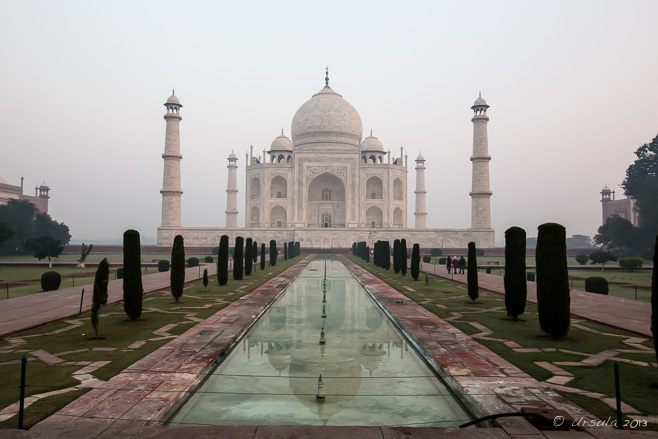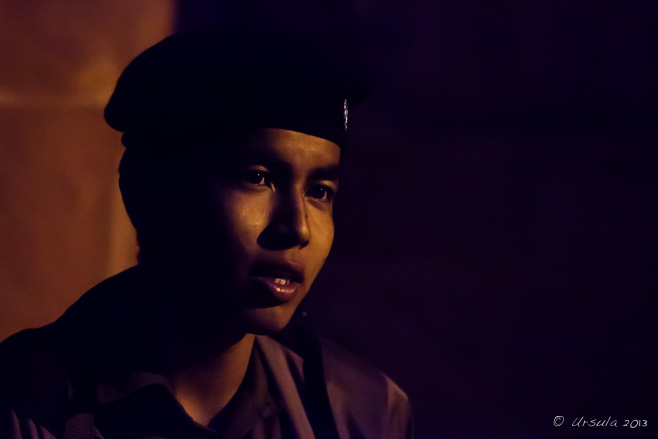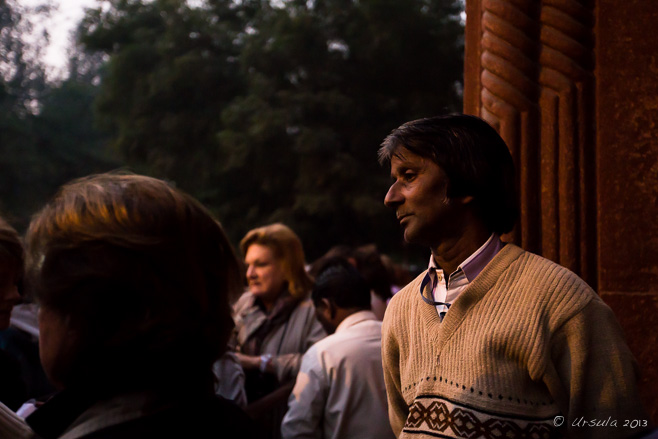
Taj Mahal Morning
The classic view of an Indian icon.
“Not a piece of architecture, as other buildings are,
but the proud passion of an emperor’s love wrought in living stones.”
We all know the story: the Taj Mahal, considered the epitome of Mughal art and architecture, was built by emperor Shah Jahan in memory of his beloved third wife, Mumtaz Mahal.
Prince Khurram, the son of Jehangir, the fourth Mughal emperor of India and the favourite grandson of Akbar the Great, was born in 1592. According to popular story, in 1607 he was wandering through Meena Bazaar when he spotted a girl selling silk and glass beads. She was the daughter of a noble Persian family and it was love at first sight. They became engaged, but were not married for five years – during which time, the prince married two other women and had two children.
He and Arjumand Banu Begum were finally married in 1612, when the prince was 20 and she was 21. In 1627, after the death of his father and a bitter power struggle with his brothers, he became the Emperor of Agra, and his favourite wife became known as Mumtaz Mahal, Persian for “the chosen one of the Palace”. She died in 1631, aged 40, giving birth to their 14th child.
Shah Jahan was heartbroken by his wife’s death, ordering the court into mourning for two years, and commencing construction of the Taj Mahal, the magnificent mausoleum to house her body, in 1632.
I was thrilled to be visiting the Taj Mahal for sunrise.
I had been in Agra once before: in 2008 with my husband. We had tried to book an early start to visit this designated UNESCO World Heritage site; our guide had told us the gates didn’t open until 9am – and then arrived an hour later than the time we had arranged with him. This time, however, I was on a photo-tour organised for me and my companions by photographer Karl Grobl and local guide DV Singh. So, we were at the gates early – very early – and still we weren’t the first! A group of American women had beat us to the front of the queue.

Morning Guard
A young guard keeps an eye on the visitors as we queue up in the cold of pre-dawn.

Spruiker
As we drink hot chai from the street vendors to keep warm, an agent offers visitors local guides.

Morning Guard
It is a long wait for 6am when the gates will open, and the light rises slowly.

Taj Entry (2013)
Once the south gates open …

Taj Entry (2008)
… people make their way into the gardens…

Taj Mahal and the Reflecting Pool
… and there it is! That most perfect of buildings!

Sunrise
We arrived on the grounds early enough to watch the sun rise over the mausoleum.

Taj Morning
Moment by moment, the white marble changes colour, along with the sky behind it.

Pilgrims on the Stairs
Wooden steps lead up to mausoleum platform.

Dome and Finial
Unlike his father and grandfather who were rather liberal, Shah Jahan was a pious Muslim. The mausoleum is built in a style that combines Islamic, Persian, Ottoman Turkish and Indian architectural elements.

Marble Carving and Inlay (2008)
The mausoleum is beautifully constructed of carved white marble, inlaid with semi-precious stones including jade, crystal, lapis lazuli, amethyst and turquoise.

Taj Mahal Mosque
As the sun rises, it angles over the mosque.

Sunrise over the Mosque
… silhouetting the minarets against the morning sky.

Yamuna River
It seems very quiet at the back of the mausoleum, where the morning mists roll over the river.

Mausoleum Marble
As the day lightens, the inlaid marble starts to gleam against the blue sky.

Visitors to the Mausoleum
No photography inside!

Visitor to the Taj
Rugged-up against the cold of Autumn, many Indians are determined to visit their heritage sites.

Visitors
Around 3 million people a year visit the Taj Mahal.

Scalloped View
Back at the main gate, the archways frame the Taj Mahal beautifully.
The story has a bitter-sweet ending. Shah Jahan became ill in 1658, and his descendants fought for rule of the empire. Aurangzeb, his third son, was the eventual winner. When Shah Jahan recovered, Aurangzeb declared him incompetent to rule and placed him under house arrest in Agra Fort. He lived out his days in a room there – able to see the Taj Mahal, the tomb of his love, but not able to leave – until his death in 1666. Then, he was reunited with his wife: interred next to her in the mausoleum he had built.

From Agra Fort (2008)
A view over the river flood-plains to the Taj Mahal from Agra Fort to the east.

The Back of the Taj
The evening before our visit to the Taj Mahal, we took advantage of the view from across the Yamuna River.
Recognised by UNESCO as “the jewel of Muslim art in India and one of the universally admired masterpieces of the world’s heritage”, the beauty of Taj Mahal has been threatened by air pollution. The structural integrity is threatened by dropping water levels and by water pollution from the Yamuna River, which reaches Agra heavily contaminated with chemical and human waste from upstream.

Sadhu
A Sadhu from a nearby camp tells us off if we venture too close to the fencing…

Razor Wire at the Back of the Taj
… but the razor-wire fencing is convincing enough on it’s own!
It is a shame that such an iconic site is so at risk. It also seems ironic, somehow, to see a tribute to love wrapped up in razor wire.

But that is India – Incredible India.
And I am thrilled to have seen it at all –
 Twice!
Twice!
That is pretty special.
Pictures: 21April2008 and 16-17November2013




























.jpg)


Beautiful memories of our earlier visit.
[…] in Uttar Pradesh, northern India, is more than just the home of the Tāj Mahal. Once the capital of the Mughal (Moghul) Empire, ruling over all of India from 1556 to […]
[…] that they, and their families, would be remembered forever. Perhaps the most magnificent of these, the Taj Mahal, stands as a testament to love and to […]
I love how the white stone marble is. I would love to visit there when I am older. I have heard that when you are in the palace there is writing on the wall, the higher you read the normal it looks. They made the texts longaded so you can see and read it as if you read it perfectly.
Hi Matthew,
The marble of Taj Mahal is indeed marvellous – though I can’t read the writing. I’m sure you will see it one day, if you decide to travel.
Cheers, Ursula
You should visit Taj Mahal again, as now it’s marble is glowing more then ever.
I would SO love to!